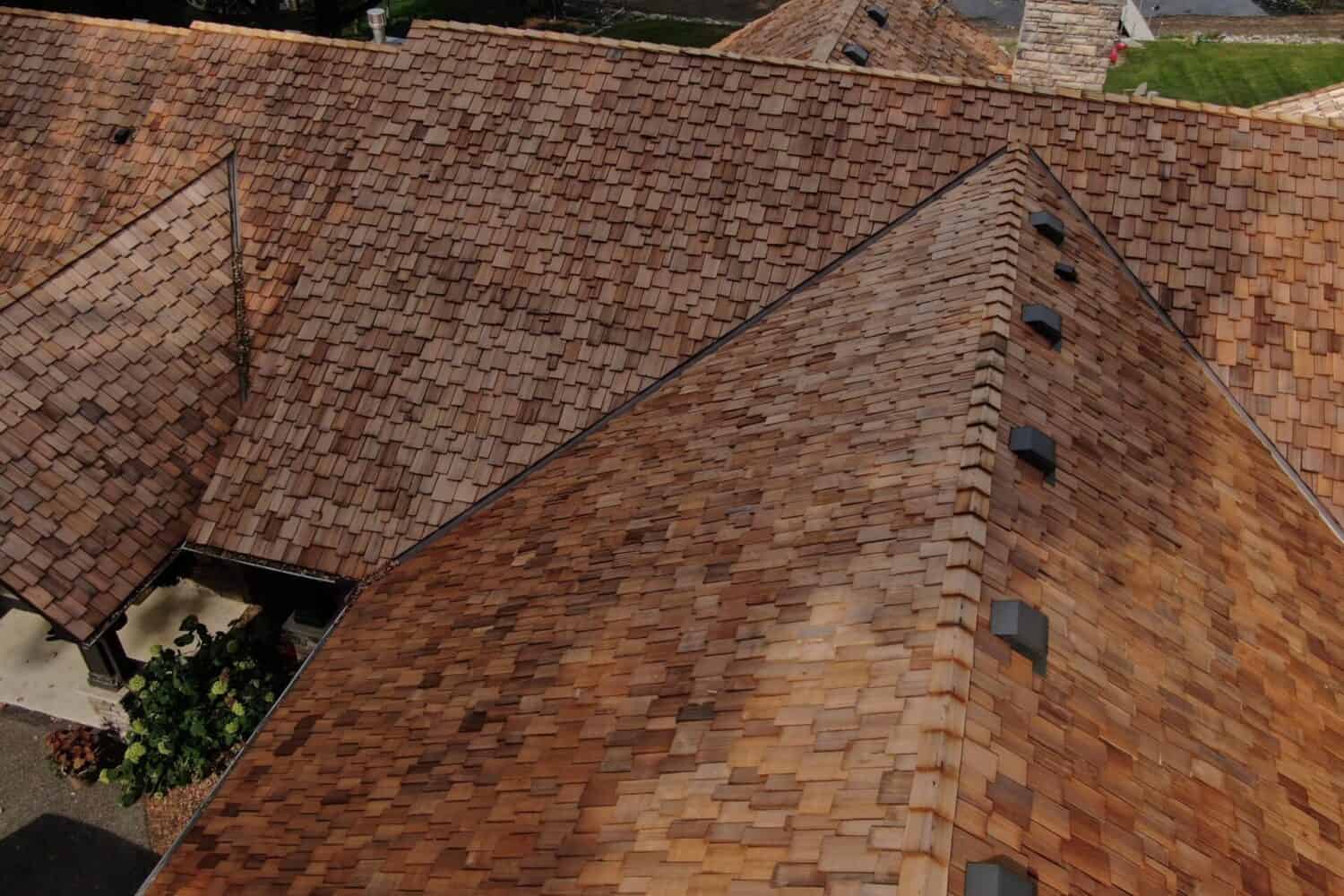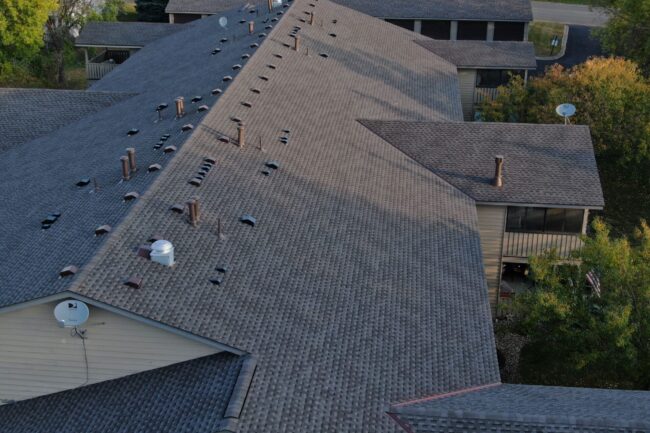Your roof is important. It keeps the interior of your house free from damage and contributes to the integrity of your house’s overall structure. Your roof also contributes to your home’s look and aesthetics. All of this adds up to the importance of maintaining a sound roof over your head. If your roof is getting old, you may be wondering how long is a roof lifespan? Do you need to start planning for a replacement? Let’s dig in and answer questions on:
- How long does a roof normally last?
- Does where you live factor into your roof lifespan?
- Are there things you can do to expand your home’s roof lifetime?
Influencing Factors: How Long Does a Roof Last?
When looking at a roof’s lifespan, there are several factors that play into how long a roof lasts.
Roofing Materials
The materials used to roof your house play a big role in how long they will last. Some roofing materials are more durable than others and it gives them more longevity. Slate shingles, for example, have the longest roof lifespan over other materials and can last as long as 100 years. If you have slate shingles, chances are they will last a long time. Asphalt or fiberglass shingles, although common, are on the other end of the longevity spectrum, lasting about 20-25 years. If your roof is made of asphalt or fiberglass shingles and were installed a couple of decades ago, they could be nearing the end of their lifespan. Cedar shingles can last about 25-30 years, while cedar shakes can last about 40-50 years. Roofs made from metal can have varying lifespans depending on the type of metal used. Aluminum and steel can last up to 50 years, while zinc or copper can last up to a century. These wide ranges in terms of longevity for different materials means knowing what your roof is made of gives you a good idea about your roof lifespan.
Quality materials also matter when looking at a roof’s longevity. Higher quality materials, no matter what they are made out of, will usually last longer than cheaper and lower quality materials. If you are a new homebuyer, it may be difficult to know the quality of the materials used to roof your house.
Roof Maintenance
Even if your roof is fairly new, maintenance matters when it comes to a roof lifespan. A roof’s longevity and the durability of roofing materials are increased when they are properly taken care of. Keeping up on this maintenance is important as a home owner to get more life out of your roof.
Climate and Weather
Your roof is exposed to the elements by design. It is built to protect the interior of your home from these same elements. If you live in a harsher climate, with frigid temperatures, or harsh sunlight, severe storms, or excessive snow, rain, hail, wind, or ice buildup, your roof is going to take a beating. Being exposed to these conditions can lower the longevity of your roof and the durability of your roofing materials, cutting down your roof lifespan.
Quality Roofing Construction
The quality of the work done by your roofer matters to how long your roof will last. A well installed roof is going to last longer than one poorly installed. A reliable, professional roofer who is known for quality work is crucial to a long roof lifespan. Signs of shoddy roofing include:
- Bad nailing techniques
- Mismatched, damaged, or missing shingles and roof stains
- Missing or poorly installed underlayment
- Missing drip edge or reused flashing
- Sagging rooflines or water leakage
All of these factors can determine the chances of your roof lasting longer than average or your roof lifespan being cut short.
Roof Lifespan in Minnesota
If climate and storms factor into the average roof life, then how long does a roof last in Minnesota?
Roof longevity in Minnesota is obviously affected by the climate and weather experienced in Minnesota. Harsh winters with lots of snow, risk of ice dams, heavy rainstorms with excessive winds or hail, and temperature extremes are all regularly experienced in Minnesota. All of this means that the average roof lifespan in Minnesota can be shorter than in other parts of the country.
Lifespan of Roof: Common Signs of Roof Damage
Some common signs that indicate that your roof life is wearing thin include:
- Spotty, wet, or discolored shingles
- Chipping or peeling paint
- Excessive, widespread rust
- Water stained or discolored interior ceilings or water drips
- Attic rafters sagging or loose-looking
- Loose or blown off shingles
- Hail dents or small, round spots from hail impact
- Cracked, curling, broken, or uneven shingles
- Black shingle granules accumulating in your gutters
- Visible deterioration around chimneys, vents, or pipes
- Peeling exterior paint along your roof’s border
- Visible sunlight getting through the roof
Making Your Roof Last Longer
You cannot change the climate where your house is located. If you live in Minnesota, then you have a Minnesota roof, which means its roof lifespan can be affected by harsh weather and severe storms. There are some things you can do though that will expand the average time a roof lasts, even in Minnesota.
Clean Your Gutters
The gutters on your home are there to help water flow off your roof and away from your home. If your gutters are clogged, water can back up and pool on your roof. Regular gutter cleaning is a part of regular roof maintenance.
Trim It Back
Cutting back trees that hang over your home, especially if you live in a climate prone to strong storms, like Minnesota, can prevent larger branches from breaking off and causing damage to your roof. Keeping trees and other landscaping features trimmed back from your house can help your roof last longer.
Remove Snow and Ice
Snow and ice buildup on a roof can add a lot of excess weight to your roof, which can cause problems and even collapse. Removing snow from your roof and avoiding excessive ice buildup can help your roof last longer even in a climate like Minnesota.
Do Regular Check Ups
Checking your roof periodically for any minor problems can help head off larger ones. Examine your roof annually for cracked or missing shingles, leaks in your attic or ceiling, or any other signs, like those listed above, that may indicate damage to the condition of your roof.
Remove Moss and Mold
Moss buildup and growing mold can damage your roof and the longer they are left to fester and grow, the bigger the damage they can cause. Keeping your roof free of moss and mold can help it last longer.
Maintain Proper Insulation and Ventilation
A well-insulated and ventilated roof is vital in keeping it in good condition and extending the durability of your roofing materials. This can be especially important in a climate like Minnesota, where snow and ice buildup can cause problems. The weight of too much snow on a roof can cause collapse, as explained above, but poor ventilation and insulation can also cause ice dams to form on your roof in winter.
Regular Roof Inspection
A word of caution though is to not extend your roof life span beyond what is considered safe. If your roof is showing signs past normal wear and tear or signs of damage begin to mount, it is time to bring in an expert to inspect your roof. A professional roof inspector can let you know if your roof lifespan is running out, if there are things you can do to extend it, or if it is time to consider a new roof.
Roof Lifespan: The Last Word
For how important your roof is to the protection, structural integrity, and aesthetic look of your home, understanding how long your roof will remain in good condition and how you can help it last longer, even if you live in a harsh climate like Minnesota, is vital to keeping a sound roof over your head.


